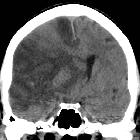zerebraler Mittellinienshift
 siehe auch
siehe auchOne of the most important indicators of increased intracranial pressure due to mass effect is midline shift.
Pathology
Any intra-axial or extra-axial lesion (tumor, hemorrhage, abscess, etc.) has the potential to exert mass effect on the brain parenchyma and cause lateral shift of the midline structures.
Radiographic features
Plain radiograph
Before the advent of cross-sectional imaging, midline shift was assessed by displacement of the calcified pineal gland on a frontal radiograph of the skull.
Ultrasound
Point of care transcranial Doppler (TCD) ultrasound has been described as a tool to supplement the physical exam in patients with suspected neurologic catastrophes . The most commonly cited method for measuring midline shift with transcranial Doppler utilizes the transtemporal window to sequentially measure the distance from the ipsilateral temporal bone to the third ventricle followed by the distance from the contralateral temporal bone to the third ventricle; subtraction of the latter value from the former divided by two is then conventionally reported as the midline shift (MLS) measurement, with zero being the expected value in a nonpathologic state. A negative value implies shift toward the observer, and positive values represent midline shift away from one's point of insonation .
Several factors limit the utility of transcranial Doppler as a reliable tool in this setting however, including inconsistently available transtemporal windows depending on patient anatomy, lack of standardization regarding angle of insonation, and the considerable user skill required to obtain consistently accurate measurements. While not currently regarded as a definitive imaging modality, it may alert the clinician to the need for further diagnostic imaging and/or monitoring .
CT/MRI
Midline shift is measured in millimeters, as the perpendicular distance between a midline structure (usually the septum pellucidum) and a line designated the midline.
The midline is assumed to be coplanar with the falx cerebri, and is best represented as a line drawn between the anterior and posterior attachments of the falx to the inner table of the skull.
Care must be taken if there is existing asymmetry of the ventricles or the falx. If the falx is not straight, a line between the free edges of the anterior and posterior falx can be used instead. The superior sagittal sinus can also be used to indicate the posterior falcine attachment provided it is truly midline and not coursing to one side as is seen sometimes with a dominant transverse sinus.
Practical points
The amount of midline shift is one of the strongest indicators of neurosurgical prognosis and can be associated with other signs of increased intracranial pressure such as:
- effacement
- sulcal
- ventricular
- asymmetry of the basal CSF cisterns
- herniation
- hydrocephalus
Siehe auch:
- Hirnödem
- transalar herniation
- Einklemmung Foramen magnum
- transtentorielle Herniation
- subfalzine Herniation
- extra cranial brain herniation
- Hirnherniation
und weiter:
 Assoziationen und Differentialdiagnosen zu zerebraler Mittellinienshift:
Assoziationen und Differentialdiagnosen zu zerebraler Mittellinienshift:
 ähnliche Suchen
ähnliche Suchen





